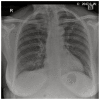Pulmonary Embolism following Endovenous Laser Ablation (EVLA) of the Great Saphenous Vein
- PMID: 22470587
- PMCID: PMC3303253
- DOI: 10.3941/jrcr.v2i2.25
Pulmonary Embolism following Endovenous Laser Ablation (EVLA) of the Great Saphenous Vein
Abstract
A 70yr old lady presented to accident and emergency with sudden onset pleuritic chest pain. A pulmonary embolus (PE) was diagnosed by CTPA. Ten days earlier she had bilateral EVLA for recurrent great saphenous vein disease. Confounding risk factors for pulmonary embolism included bilateral ligation and stripping of the great saphenous vein a year earlier, malignancy, EVLA and phlebitic tributary varices. EVLA has been shown to be an effective treatment for superficial venous insufficiency with low morbidity and high patient satisfaction. The investigation of confounding risk factors and possible causes should not compromise the initial treatment of PE.
Figures






References
-
- Wells PS, Ginsberg JS, Anderson DR, Kearon C, Gent M, Turpie AG, et al. Use of a clinical model for safe management of patients with suspected pulmonary embolism. Ann Intern Med. 1998;129(12):997–1005. - PubMed
-
- Navarro L, Min R, Bone C. Endovenous laser: a new minimally invasive method of treatment for varicose veins--preliminary observations using an 810 nm diode laser. Dermatol Surg. 2001;27:117–122. - PubMed
-
- IPG052 Endovenous laser treatment of the long saphenous vein - information for people considering the procedure, and for the public. National Institute for Clinical Excellence; Mar, 2004. http://www.nice.org.uk/nicemedia/pdf/IPG052publicinfo.pdf.
-
- Min R, Khilnani N, Zimmet S. Endovenous Laser Treatment of Saphenous Vein Reflux: Long-Term Results. J Vasc Interv Radiol. 2003;14:991–996. - PubMed
-
- Durai R, Srodon PD, Kyriakides C. Endovenous laser ablation for superficial venous insufficiency. Int J Clin Pract. 2008 - PubMed
LinkOut - more resources
Full Text Sources
